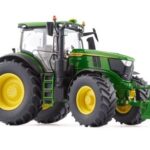
Front-End Loaders for Sale A Comprehensive Guide
Tractors with front-end loaders are versatile pieces of equipment widely used in agriculture, construction, landscaping, and other industries. These machines combine the power and utility of a tractor with the flexibility of a front-end loader, making them invaluable for a variety of tasks. If you’re in the market for a tractor with a front-end loader, this guide will provide you with all the information you need to make an informed decision.
What is a Tractor with a Front-End Loader?
A tractor with a front-end loader (FEL) is essentially a tractor equipped with a hydraulic-operated front bucket. This attachment allows the tractor to scoop, lift, transport, and unload materials like soil, gravel, sand, and debris. The combination of a tractor’s robust power and the loader’s versatility makes these machines suitable for many different applications.
Key Features and Specifications
- Engine Power: Tractors are rated by their horsepower (HP), which ranges from 20 HP for small utility tractors to over 200 HP for large agricultural machines. The choice of horsepower depends on the tasks you plan to perform. Light-duty work requires less power, while heavy-duty operations need higher horsepower.
- Loader Capacity: The loader’s lift capacity indicates how much weight it can lift. This varies widely based on the model and size of the tractor. Lift height is another critical specification, determining how high the loader can raise its bucket.
- Hydraulic System: A robust hydraulic system is essential for smooth and efficient operation of the loader. Hydraulic flow rate, measured in gallons per minute (GPM), affects the speed and strength of the loader’s movements.
- Attachments and Implements: In addition to front-end loaders, tractors can be equipped with various attachments like backhoes, mowers, and tillers.Quick-attach systems make it easy to switch between different implements.
Types of Tractors with Front-End Loaders
Compact Tractors:
Ideal for small farms, landscaping, and residential use.
Typically range from 20 to 50 HP.
Highly maneuverable and easy to operate.
Utility Tractors:
Versatile and suitable for a wide range of tasks, including mowing, digging, and hauling.
Generally range from 50 to 100 HP.
More robust than compact tractors and can handle larger implements.
Row Crop Tractors:
Designed for agricultural use, particularly for row crop farming.
Usually range from 100 to 200 HP.
Equipped with features to handle heavy-duty farming tasks.
Industrial Tractors:
Built for construction and industrial applications.
Often have reinforced frames and higher lift capacities.
Can exceed 200 HP, providing the power needed for demanding jobs.
Benefits of Owning a Tractor with a Front-End Loader
- Versatility: Can be used for a wide range of tasks, reducing the need for multiple machines. Easily adaptable with various attachments for different jobs.
- Efficiency: Increases productivity by performing tasks quickly and efficiently. Reduces manual labor, saving time and effort.
- Cost-Effectiveness: While the initial investment can be significant, the versatility and durability of these machines offer long-term cost savings. Maintenance is relatively straightforward, especially with proper care and regular servicing.
- Durability: Built to withstand rigorous use in tough conditions. High-quality models can last for decades with proper maintenance. Factors to Consider When Buying a Tractor with a Front-End Loader Intended Use:
Define the primary tasks you need the tractor for
This will help determine the appropriate size, power, and features.
- Budget: Tractors with front-end loaders can range from a few thousand dollars for used models to over $100,000 for high-end new models.Consider financing options and the long-term return on investment.
- Brand and Dealer Support: Reputable brands typically offer better reliability, resale value, and customer support. Local dealer support is crucial for maintenance, repairs, and access to parts.
- Warranty and After-Sales Service: Ensure the tractor comes with a comprehensive warranty. After-sales service, including regular maintenance and repairs, is vital for the longevity of the machine.
- New vs. Used: New tractors come with the latest technology and warranty protection but at a higher cost. Used tractors are more affordable but require thorough inspection and possible repairs. Popular Brands and Models
- John Deere: Known for its durability and extensive dealer network. Popular models include the 1025R for compact needs and the 5E Series for utility purposes.
- Kubota: Renowned for reliability and ease of use. The BX Series is ideal for small-scale tasks, while the M Series suits larger agricultural operations.
- Massey Ferguson: Offers a wide range of tractors with excellent performance. The GC1700 Series is perfect for compact needs, and the 5700 Series for more extensive farming tasks.
- New Holland: Combines advanced technology with robust design. The Workmaster Series is favored for its versatility and affordability.
- Regular Inspections: Conduct routine checks of the hydraulic system, tires, and engine. Look for signs of wear and tear, leaks, or loose components.
- Lubrication: Ensure all moving parts are properly lubricated to reduce friction and prevent wear. Follow the manufacturer’s recommendations for lubricants and intervals.
Conclusion
Tractors with front-end loaders are essential machines for various tasks in agriculture, construction, and landscaping. They offer unparalleled versatility, efficiency, and cost-effectiveness. When purchasing one, consider factors such as intended use, budget, brand reputation, and after-sales support. Whether you choose a new or used model, proper maintenance is key to ensuring your tractor remains in excellent working condition for years to come. By making an informed decision, you can invest in a machine that will significantly enhance your productivity and operational capabilities.










